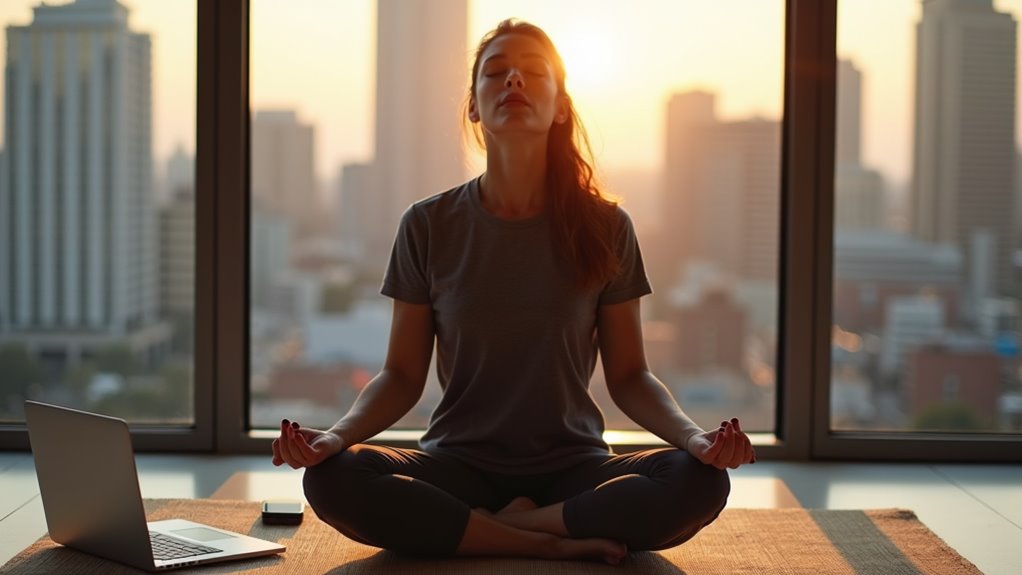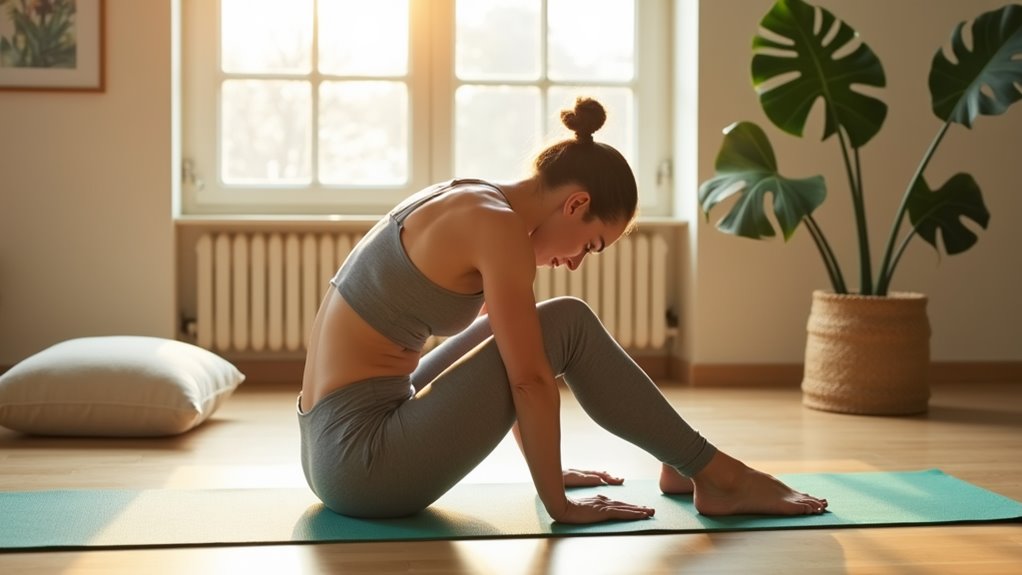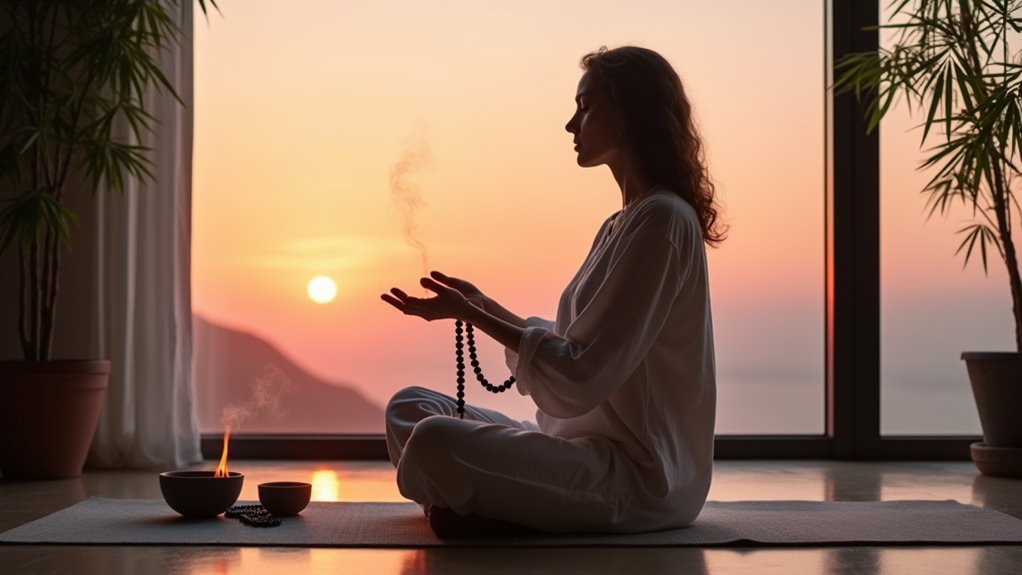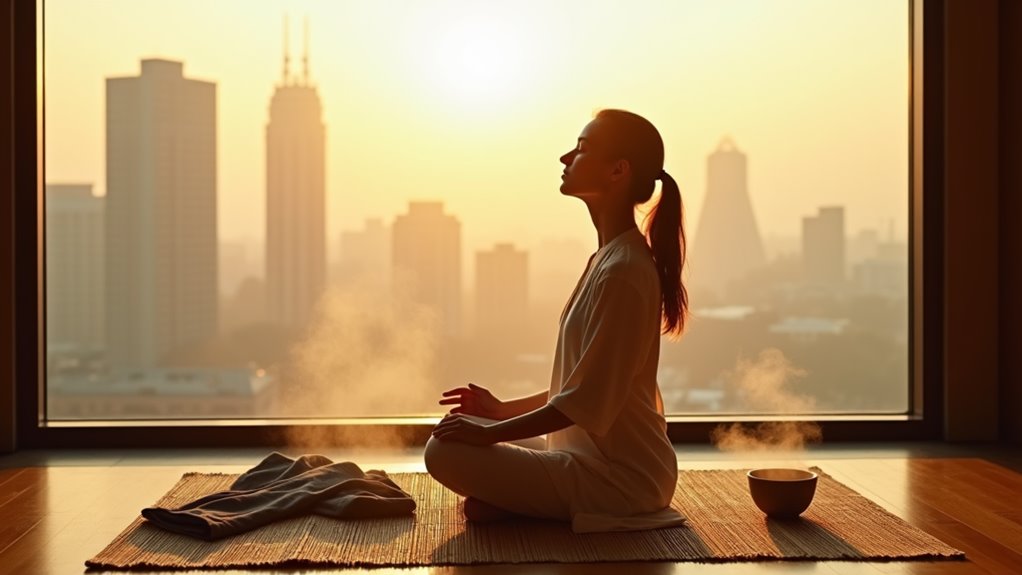You can find serenity in your busy life through simple yoga and meditation practices. Even five minutes of mindful moments, like morning stretches or conscious breathing, can transform your day. Start with desk-friendly poses like seated twists and shoulder shrugs to release tension at work. Create a peaceful corner at home for dedicated practice, incorporating soft lighting and natural elements. Build sustainable wellness habits by establishing quick morning and evening rituals that anchor your day. Your journey to inner peace doesn't require hours – just commitment to small, consistent steps that yield profound results.
Key Takeaways
- Start with five-minute morning yoga stretches, including cat-cow and downward dog poses, to energize your body before work.
- Transform everyday activities into mindful moments by focusing on sensory experiences during morning coffee or walking.
- Create a dedicated clutter-free space with soft lighting and comfortable cushions for uninterrupted practice.
- Practice desk-friendly yoga poses like seated twists and shoulder shrugs to relieve tension during work hours.
- Establish consistent morning and evening rituals that combine gentle stretching and breathing exercises for better sleep-wake transitions.
Why Yoga and Meditation Matter

While modern life bombards us with constant distractions and stress, yoga and meditation offer a powerful antidote to our hectic routines.
These ancient practices help you reconnect with your body and mind, creating a sanctuary of calm in your daily life.
You'll discover that regular yoga practice improves your physical strength, flexibility, and posture while reducing chronic pain and tension.
Meanwhile, meditation enhances your mental clarity, emotional balance, and decision-making abilities.
Together, they lower your blood pressure, boost immune function, and regulate sleep patterns.
When you integrate these practices into your schedule, you're investing in both your immediate well-being and long-term health.
Even brief sessions can help you manage anxiety, increase focus, and develop resilience against life's challenges.
Quick Mindfulness for Daily Life
Although finding time for lengthy meditation sessions may seem daunting, you can practice mindfulness during everyday activities.
Turn your morning coffee ritual into a mindful moment by focusing on the aroma, warmth, and taste. While commuting, observe your breath or notice the sensations in your body instead of scrolling through your phone.
You'll find countless opportunities to incorporate awareness throughout your day. Practice mindful walking between meetings by feeling each step, or take three conscious breaths before responding to emails.
When eating lunch, savor each bite rather than rushing through your meal. Even washing dishes can become a meditative practice when you fully engage with the sensations of water, soap, and movement.
Five-Minute Yoga Poses

You'll be amazed at how just five minutes of targeted yoga poses can energize your entire day.
Start with quick morning stretches like cat-cow and downward dog to wake up your spine and muscles before rushing out the door.
When you're stuck at your desk, simple seated twists and shoulder rolls can help relieve tension and improve your posture.
Quick Morning Stretches
Even with the most hectic morning schedule, dedicating just five minutes to simple yoga poses can energize your body and mind for the day ahead.
Start by standing tall and raising your arms overhead for a full-body stretch, then gently fold forward to touch your toes, letting your head hang loose.
Move to your hands and knees for cat-cow stretches, alternating between arching and rounding your back.
Follow with child's pose, extending your arms forward while sitting back on your heels.
Finish in a seated position with a gentle spinal twist – place your right hand behind you, left hand on your right knee, and slowly turn to look over your right shoulder.
Repeat on the opposite side to release any remaining tension.
Desk-Friendly Yoga Poses
Building on your morning yoga routine, desk-friendly poses offer a perfect way to maintain mindfulness throughout your workday.
You'll find these seated stretches both discreet and effective for releasing tension and improving posture.
Start with neck rolls, gently rotating your head in slow circles.
Next, try shoulder shrugs – lift your shoulders to your ears, hold for three seconds, then release.
For wrist relief, extend your arms and rotate your hands in circles.
The seated cat-cow involves arching your back while seated, then rounding it while pulling your navel in.
Finally, practice ankle rotations under your desk to improve circulation.
You can perform these poses individually whenever you need a break, or combine them into a five-minute sequence between tasks.
Creating Your Sacred Space
Every successful yoga and meditation practice begins with a dedicated space that speaks to your soul. Choose a quiet corner in your home where you won't be disturbed, even if it's just a small nook in your bedroom.
Keep this area clutter-free and purposeful. Add elements that calm your senses: soft lighting, natural materials, and perhaps a small altar with meaningful objects.
You'll want a supportive cushion or mat, and consider incorporating plants or essential oils to enhance the atmosphere. The space doesn't need to be elaborate – simplicity often works best.
Make this space off-limits during your practice time. When you establish boundaries around your sacred space, you're telling yourself and others that your wellness matters, making it easier to maintain a consistent practice.
Morning and Evening Rituals

While the idea of daily rituals may seem daunting, establishing simple routines for both sunrise and sunset can anchor your practice in manageable ways.
Start your morning with five minutes of gentle stretching followed by three deep breaths before your feet touch the floor. As you progress, add a brief meditation or a few sun salutations.
In the evening, create a wind-down sequence that signals your body it's time to rest. You might practice gentle forward folds, try a calming breathing exercise, or sit quietly for a few minutes.
Don't force yourself to maintain lengthy sessions – even brief moments of mindfulness can transform your day. These rituals will gradually become second nature, creating peaceful transitions between sleep and wakefulness that support your wellbeing.
Building Sustainable Wellness Habits
Anyone can start a wellness practice, but maintaining it requires thoughtful strategy and realistic expectations.
You'll find success by starting small and gradually expanding your practice. Choose a specific time each day, even if it's just five minutes, and stick to it until it becomes second nature.
Track your progress using a wellness journal or app, noting how you feel before and after each session.
When life gets hectic, don't abandon your practice entirely – instead, adapt it. If you can't do a 30-minute yoga session, do a 5-minute stretch break.
Remember that consistency matters more than perfection. Connect with like-minded people, whether through local classes or online communities, who'll support your journey and help you stay accountable to your wellness goals.
Frequently Asked Questions
Can I Practice Yoga if I Have Physical Injuries or Chronic Pain?
You can practice yoga with injuries or chronic pain, but you'll need to modify poses and work with qualified instructors who understand your condition.
It's essential to inform your teacher about your limitations and listen to your body. Many gentle yoga styles, like restorative or chair yoga, are specifically designed for people with physical challenges.
Always get your doctor's approval before starting any new exercise routine.
What Should I Wear During Meditation Sessions at Home?
Light as a feather, your meditation attire should prioritize comfort above all else.
You'll want to wear loose-fitting, breathable clothes that won't distract you during your practice. Choose soft fabrics like cotton or bamboo that move with your body.
Skip tight waistbands, scratchy materials, or noisy fabrics. While you can meditate in anything, pajamas or loose athletic wear are perfect choices for home sessions.
How Do I Know if I'm Doing the Breathing Exercises Correctly?
You'll know you're breathing correctly when you feel your belly expand on the inhale and fall on the exhale.
Place one hand on your stomach and one on your chest – your belly should move more than your chest. Your breath should be smooth, without gasping or forcing.
Proper breathing feels natural and relaxing, creating a gentle rhythm that helps you stay focused and calm.
Is It Okay to Eat Before Practicing Yoga or Meditation?
You'll want to avoid heavy meals 2-3 hours before yoga or meditation.
A light snack like fruit or nuts is fine if you're hungry, but eat it at least 30 minutes before practice. Full stomachs can make you uncomfortable, interfere with breathing, and limit your movement during poses.
For meditation, hunger can be distracting, so a small snack might help you focus better.
Can Children and Elderly People Safely Participate in Yoga Practices?
Studies show that children who practice yoga experience a 20% improvement in focus and emotional regulation.
You'll find that both children and elderly individuals can safely enjoy yoga, but they should follow age-appropriate modifications.
Children benefit from playful, shorter sessions, while seniors should focus on gentle poses with proper support.
It's essential to work with qualified instructors who understand specific age-group needs and limitations.
Conclusion
Like water shaping stones over time, your daily practice of yoga and meditation will gradually transform your busy life into a more peaceful journey. You'll discover that even stolen moments of mindfulness can become stepping stones across life's rushing river. By weaving these practices into your daily rhythm, you're cultivating an inner garden of serenity that flourishes despite life's storms.

Leave a Reply